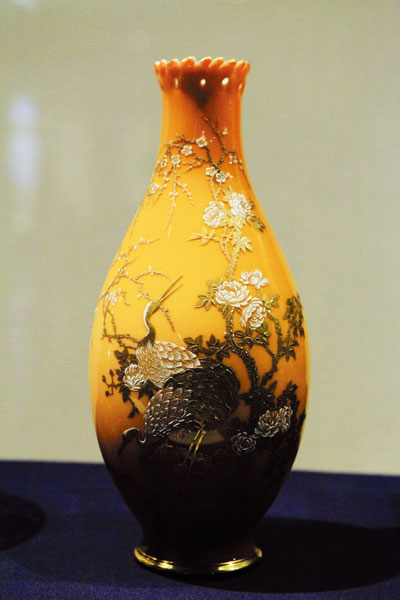 Cao Zhen caozhen0806@126.com THE soft gleam of a green German beaker, the luminous glow of an old Bohemian decanter, a glittering wine jar from Spain. These are among the many reflective and mysterious surfaces that temper the bright splash and splendor of a European glass exhibition going on now at the Shenzhen Museum. More than 200 glass pieces on loan from the Museum of Decorative Arts in Prague are on display, offering a thoughtful, expressive, and utterly breathtaking exploration of glassmaking in Europe from the 4th century B.C. to the present day. According to Dusan Seidl, director of the foreign exchange department of the Museum of Decorative Arts in Prague, the collections of glass, ceramics and porcelain are among the largest and most significant holdings of his museum, which was founded in 1885. There are 20,000 items in the glass collections, the largest section being examples of Czech origin. The exhibits, mostly drinking glasses, are grouped in chronological order. There is a large collection of Renaissance Bohemian glass with enamel paintings and extravagantly cut glass bowls, plates, vases, goblets and bottles spanning from the late Renaissance period to the 20th century. Glass from other glassmaking regions of Europe such as the Roman Empire, Holland and Spain are also on display. Seidl said that due to abundant natural resources in the countryside, Bohemian glass has a centuries-long history of being internationally recognized for its high quality, artisanship, beauty and often innovative designs. Hand-cut, engraved, blown and painted decorative glassware ranging from champagne flutes to enormous chandeliers, ornaments, figurines and other glass items are among the best-known Czech exports and are immensely popular tourist souvenirs. Influenced by migrating Bohemian crafters, glass items produced in Germany, Austria, Britain and France are also prominent and distinctive. If the glassware from the Middle Ages period appears to be simple and bleak, enamel paintings of churches, flowers, landscapes and Roman kings on Renaissance glassware with extravagant shapes cast brilliant visual effects. At the exhibition, visitors can also admire reserve glass paintings, another Czech specialty produced in the early 18th century. An image is carefully painted by hand on the back of a pane of glass, using a variety of techniques and materials, and then viewed by turning the glass over and looking through the glass at the image. This art form is among the masterpieces of Baroque glass. Glassware painted in the Rococo style from the second half of the 18th century was of particular importance to the development of painted glass in Bohemia. And drinking glasses decorated with beads and shells are quite distinct. The collection of Bohemian glass in the Biedermeier style from the first half of the 19th century, along with the Art Nouveau pieces, and 20th century mass-produced and one-off pieces of glass all are also on display at the exhibition. One of the most celebrated periods of Czech glassmaking, the Art Nouveau era, found its most profound manifestation in the wide variety of shapes of iridescent vases, appearing to change color when viewed from different angles. Documentaries on European glassmaking are shown inside the museum as part of the exhibition. Dates: Until June 12 Hours: 10 a.m.-6 p.m. Venue: Shenzhen Museum, Block A, Civic Center, Futian District (福田区市民中心A区深圳博物馆新馆) Metro: Shekou or Longhua Line, Civic Center Station (市民中心站), Exit B | 
